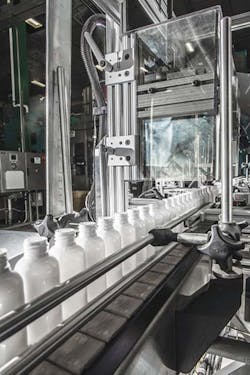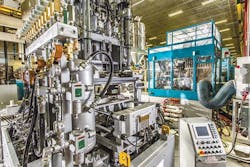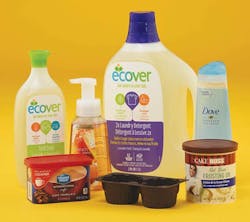Sonoco broadens scope of plastics operations
Sonoco Products Co. has annual sales of about $5 billion with 20,800 employees worldwide focused on consumer packaging. To get a grasp on the company's plastics operations, Plastics Machinery Magazine went to command central — Sonoco's headquarters in Hartsville, S.C. — where one pilot plant alone is 100,000 square feet.
Sonoco also operates its own machine and tool shop in a separate facility. Officials provided a tour of the campus and insight into how Sonoco thinks of its plastics business. The worldwide plastics operation has 20 production-scale facilities with blow molding, thermoforming, injection molding and tubing extrusion. These facilities work in concert with the rest of Sonoco's operations to produce consumer packaging and industrial and display products. Examples include the Planters peanut jar that was converted from glass to plastic and packaging for personal care products such as the Dove and Vaseline brands. Machinery technology constantly is being pushed and tinkered with at the pilot plant as officials work to get the latest and greatest packaging designs into consumers' hands.
The plastics business has experienced what officials call the "great turnaround" at Sonoco. It is a consumer products company that happens to process plastic, a lot of it. Its major processes—blow molding, injection molding and thermoforming —once operated as three separate divisions with three separate teams. Those now are all aligned under one global operating unit, Sonoco Plastics. Under new leadership, it is becoming process-agnostic.
"We want to become customer-centric and focus on end-use markets," says Jeff D. DiPasquale, the company's division VP and GM of Global Plastics. "We're getting away from platform selling. Sometimes we're selling all those components to the same customer. It's a change as to how we're going to market. We need to be selling in end-use markets. We have a very diverse set of capabilities but those are all real complementary to each other when you're looking at a total package solution for a customer. Sometimes it's plastics and sometimes it isn't."
TRANSFORMATIONAL INNOVATION
Sonoco's President and CEO Jack Sanders took those titles in 2013. Under his leadership, the company was charged with innovating packaging for retail products. As a consumer, you've no doubt seen the names on Sonoco's packaging products: Gillette, Tetley, Nestlé, just to name a few. More recently, some innovations include work on a clear, resealable rigid container for pet treats and a partnership with Gillette for the packaging on Gillette's Fusion ProGlide manual razor. The Sonoco Alloyd division won an AmeriStar Packaging Award in the household products category from the Institute of Packaging Professionals for the Whirlpool Water EveryDrop water filter package This was a reinvention of packaging for an on-the-go water filter.
Among consumers spread across the globe, speed to market is key. With fickle consumer tastes, a trend in January could be gone by May, replaced with another that a company like Sonoco has to be ready to tackle. One package had to go from concept to market in seven months.
The big buzz at Sonoco's headquarters is the IPS Studio, a 2,000-square-foot innovation center that is scheduled to open later this year. It is under construction and located within the same building as the pilot plant. It was conceived under Sonoco's mantra, "Sometimes where you think inspires what you think." Insights will be connected to product invention, says Marcy Thompson, VP, marketing and innovation. The IPS (Innovative Packaging Solutions) Studio will bring together the packaging engineers, marketing gurus, entrepreneurs and designers. Consumer focus groups will meet there. Concepts will be turned into carefully engineered prototypes. Sonoco will gauge the feasibility of products through design engineering and material science and the use of a rapid prototyping lab, 3-D printing and an FDA-registered food fill facility. Food products will be packaged here. Along with the pilot plant, the goal is to have everything in one place for better collaboration and speed to market.
"Speed to market is critical," says Thompson. "The studio will make us more efficient."
Sonoco uses its i6 innovation process to come up with packaging products. That innovation process is based on six steps: insights, ideation, invention, integration, interaction and iteration. That is the engine that drives how packaging is conceived and brought to market. Sanders says that one of the leading indicators for innovation and growth is the number of patent applications leading to new product development. Sonoco standardized its front-end process to encourage purpose-driven innovation through the i6 process implemented under Sanders. The company has had a record 33 percent increase in its Record of Innovations—its designation for inventions—and a 25 percent increase in U.S. patent applications in 2014 compared to the prior three-year average.
That innovation guideline is process-agnostic, says Thompson.
"As we look at macro trends, consumers are gravitating to more fresh and natural products and products that provide trust and transparency cues," she says. "The benefits plastic packaging provides resonate with our customers and consumers as it is versatile in shape, color, transparency and functionality. So it plays a big part in our overall growth strategy and is one of the fastest-growing packaging formats."
Each official talks with great enthusiasm about taking the studio from concept to reality. This is a big deal within Sonoco and plastics operations will play a huge part. This pilot plant currently is outfitted with each process mentioned and also includes 3-D printing. On the day of the tour, a Fortus 250 MC from Stratasys Ltd, Eden Prairie, Minn., was printing a prototype mold for a blister pack. Once a mold is prototyped, officials can go across the street to the machinery manufacturing shop, says Jeff Schuetz, staff VP, consumer packaging global technology. If Sonoco cannot find equipment from a supplier to suit its needs, it will create its own.
"We make a lot of our own equipment," he says. "So if we need something of a little bit better quality, we can actually go across the street and build an aluminum mold or something like that. Depending upon the project and speed and quality, we pick the best option to get something into the customer's hands."
Within the pilot plant is where materials and processes are tested and proven and this is where even more plastics testing will take place once the studio has opened. The $12 million investment includes additional capabilities that will encompass prototyping and short runs, says Schuetz. In 3-D printing, Sonoco will update its technology to the most recent models.
"What is happening is bigger build envelopes, so we can make larger parts, and a greater variety of materials," he says. "Materials are becoming more realistic, so (it's) getting into more supple materials, etc.
"In the prototyping area we are supplementing capabilities in 3-D printing to produce higher quality parts as well as improved digital printing equipment to produce labels with high-quality graphics," he says. "We are also adding pilot equipment to complement our existing blow molding, sheet and thermoforming capabilities."
Schuetz stands on a platform overlooking the pilot production floor and points out an extrusion line that occupies one corner. It is a convertible line that can produce sheet up to seven layers or tubing if Schuetz's team needs that capability. Packaging products like caulk tubes are tested and proven on that line.
That line first was installed about 12 years ago and it was a co-extrusion sheet line supplied as a turnkey system. Schuetz and team recently added the tube capability so that it now can swing back and forth to support both platforms. Without disclosing the suppliers, Schuetz said that the new tube die and back end were made by different OEMs and integrated into the existing system by Sonoco.
"We are able to leverage the same front end and change the die and the cooling/haul-off system of the plastic to swing between tube and sheet," explains Schuetz, a materials engineer. "Again, versatility is what we're after. We're not here necessarily for manufacturing efficiencies. We are always mixing and matching equipment."
Machinery Selection: Related to the run
Consumers want fast, easy, convenient products. Think about what were once known as TV dinners – those frozen meals that could be popped into the oven for mealtime. The primary material used to be CPET because the crystallized resin has a very good heat resistance. But who puts those trays in the oven anymore?
"As consumer trends evolve, most consumers don't need CPET anymore because they don't put their frozen meals in the oven," says Schuetz. "They put it in the microwave. The microwave can handle PP. We have been transitioning our assets from CPET to PP as the market evolves."
Sonoco still runs CPET. It is a very important material for the company and the market demand remains significant, he says. But Sonoco figured out how to use the same equipment for the transition. The assets used for this include a post-trim thermoforming line from Lyle Industries LLC, one of two thermoforming lines at the pilot site. It's the same equipment but a very different process setting to run a variety of materials.
Its line from Gabler Thermoform GmbH & Co. KG is trim-in-place, which is used for very accurate flanges. For example, if Sonoco has a part that requires a metal seam on the end, the dimensional control of trim-in-place is necessary. Still, the bulk of the company's thermoforming assets is post-trim.
Sonoco also has rotary thermoforming, which is a proprietary process because Sonoco designs and assembles these machines in-house. Officials use the process for very high efficiencies, for example, Stouffer's frozen food trays, which are produced in the millions. They run both CPET and PP on those lines.
"You do not want to change those machines out a lot because there are a lot of molds," he says. "Whereas flat bed we'll use for shorter- to medium-run applications. It's the same thing in blow molding. We use shuttles for short runs and wheels for long run. A lot of companies do one or the other. Again, even big customers have short-run business. Whether you are market-focused or customer-focused, we really think you need to have both to be able to appropriately supply the customer at the lowest possible cost."
In blow molding, Sonoco's expertise is in extrusion blow molding (EBM) and injection stretch blow molding (ISBM). In EBM, the technologies include mono- and multi-layer, gradation and barrier. In ISBM, technologies include one- and two-stage and active barrier. The pilot plant is equipped with a Bekum America Corp. shuttle blow molder for development work. It is the same model that Sonoco has in many of its manufacturing facilities. Officials typically work with one or two molds on that machine and Schuetz said that it is a very versatile machine in terms of size. The company can mold up to six layers on that equipment.
The technology in blow molding was critical to the development of a product for beauty care in which the color appearance changes within the bottle. This is called gradation and Sonoco is using it in multi-layer bottles.
"Unilever has leveraged this a lot in its Dove brand, for example," says Schuetz. "We can do color to color or color to clear. It is multi-layer extrusion blow molded where we actually turn the pigmented layer on and off in registration with the mold. Every bottle is a little unique. But if you line these up on the store shelves you're going to see a very consistent brand image."
Brand recognition is key, says Thompson.
"Does it register (as) a premium?" she questions about what happens in the consumers' minds when they see it on the shelves. "What do you think when you see it on the shelf? We are actually getting some of those insights now."
Injection Molded IML Development:
Integrating an Acquisition
Sonoco's plastics operations have come through a blend of acquisition and organic growth, says DiPasquale.
Late in 2014, Sonoco acquired Weidenhammer Packaging Group, Hockenheim, Germany. The technology acquired there includes state-of-the-art, thin-walled injection molding technology with modern in-mold labeling (IML).
IML will be pursued in injection molding, not necessarily thermoforming, where the technology also is available.
"It is at the top of our list for areas in which we'd like to grow," says DiPasquale. "We've got varying degrees of injection molding machine platforms across our business. In some of our plants, we have some machines where we are doing in-mold labeling. The capability gives us a chance to do very unique shapes and gives customers options about branding. Investing in assets like that, I think that is a competitive advantage."
At the pilot facility, Schuetz has ordered that plant's first injection molding machine that will be complete with robotics for IML. Schuetz would not disclose the supplier but said that it is a 100-ton press with two-shot capability and a six-axis robot. It will be operational in the third quarter.
Finding that press wasn't so simple because Sonoco needed a small molding machine that it would be able to scale up with single- or dual-cavity molds to support injection molding development work.
"We've kind of struggled with that one because there are so many different tonnages of machines, depending upon whether you're making a hollow part, a solid part, etc.," says Schuetz. "There really is no one good machine to have in a pilot plant so we still do a lot of our injection molding development either at suppliers or on our production equipment because there is such a variety."
Making the purchasing decisions
To keep up with demand and the need to stay innovative, Sonoco is investing in its assets. Although officials would not disclose the amount, the company will invest significantly in machinery for plastics this year.
The pilot plant is just an example, and of course, the nerve center where processes are proven before they are taken into the production-scale sites.
When it comes to equipment, the product can dictate what is chosen. But in some cases, Sonoco already knows what it wants. Its facility in Franklin Park, Ill., recently added a 52-inch thermoforming line from Thermoforming Systems LLC, Union Gap, Wash., with all the requisite bells and whistles. This line will make products sold into the food-service produce and portion-control markets.
"In some cases, we are reinvesting with vendors that we have good relationships with," says DiPasquale. "In other cases we purchase equipment based on need. The selection of equipment may be product -specific."
When it comes to extrusion blow molding, Sonoco sticks with Bekum.
"Those have served us very well. We don't see any need to change," he says. In personal care products for single-stage PET blow molders, Nissei ASB is the predominant supplier.
"There are very good, strategic relationships we have," he says. "There are other purchases that will be very process specific. Our technology group, along with our own division, engineers and manufacturing people work on what technology we are deploying.
"Capital spend is based on a lot of opportunities that come our way," says DiPasquale. "This year, we've got some real solid opportunities going on that require us to add new machines and/or replace old ones."
Angie DeRosa, managing editor
Contact:
Sonoco Products Co., 848-383-7000, www.sonoco.com




